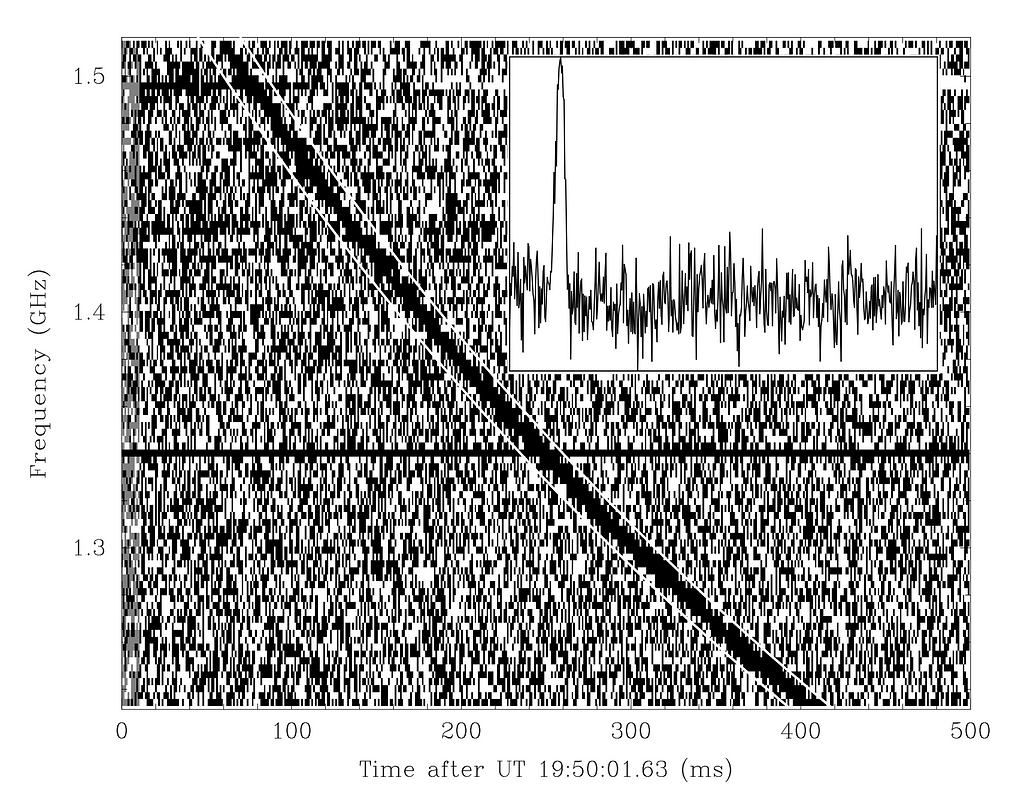
A new paper reported the discovery of the repeating source of fast radio bursts, labeled FRB 20240209A. The FRB was discovered by the Canadian Hydrogen Intensity Mapping Experiment (CHIME) telescope. The localization was constrained to a small region on the sky, which is an arcsecond wide and two arcseconds long. Deep observations with the Keck and Gemini telescopes provide a robust association of the source with the outskirts of a bright galaxy with a luminosity that is a few times larger than that of the Milky-Way. This FRB has a projected physical offset of about 130,000 light years from the center of its host galaxy, making it the farthest FRB ever detected from a host galaxy.
A companion paper studied the properties of the host galaxy at a redshift of z=0.14. The stellar population model suggests that the host galaxy contains of order a trillion stars with a total of 300 billion solar masses and an average age of 11 billion years. This corresponds to the most massive and oldest host ever discovered for an FRB. Despite the total stellar mass being a few times above that of the Milky-Way, the star formation rate is less than a third of the Milky-Way value, implying a quiescent galaxy with a small population of young stars.
The large offset and the quiescent nature of the host elliptical galaxy imply that this FRB is not a product of a newly born star. Other possible sources for FRB 20240209A are magnetars formed through merging neutron stars or white dwarfs or an accretion-induced collapse of a white dwarf.
However, the most popular models associate FRBs with a young highly-magnetized neutron star, commonly called a magnetar, born out of the collapse of the core of a massive star. Massive stars have a short lifespan. A magnetar born in a supernova requires recent star formation, which is not readily available in this host elliptical galaxy. Similar circumstances were inferred in another source FRB 20200120E, which was found to reside in an old globular cluster in the galaxy M81 with no star formation, also at the outskirts of its host galaxy.
Eight years ago, I co-authored a paper with my then-postdoc Manasvi Lingam, which suggested that some Fast Radio Bursts might be the technological signature of extragalactic civilizations. In particular, we showed that the radio beams needed to power large light sails could yield parameters that are consistent with FRBs at cosmological distances. The required diameter of the beam emitter was found to be comparable to the size of Earth and the optimal frequency for powering the light sail was shown to be similar to the observed FRB frequencies. These coincidences provide further motivation for exploring the possible artificial origin of some FRBs sources.
In the same year, I published a separate paper with Dani Maoz which argued that if FRBs originate from galaxies like the Milky-Way at cosmological distances, then the Milky-Way itself should give rise to a bright FRB every few decades to a millennium. Given that the size of the Milky-Way is a million times smaller than the cosmic horizon, a Galactic FRB could produce a gigahertz radio pulse of flux that is a trillion times brighter than an FRB at cosmological distances. As this would be comparable to the fluxes and frequencies detectable by cellular communication devices in the form of cell phones, Wi-Fi and GPS, it is possible to search for Galactic FRBs with a global array of low-cost radio receivers.
The possible use of an app on cellular phones by citizen scientists would allow them to continuously upload information to a central data-processing website which will identify a real, globe-encompassing, FRB from an astronomical distance. Triangulation of the GPS-based pulse arrival times reported from different Earth locations would provide the FRB sky position, potentially to arcsecond accuracy. Pulse arrival times from phones operating at different frequencies would constrain the likely source distance from the column of free electrons, so-called “dispersion measure,” within the Milky-Way.
Detecting a radio burst from the launch of a massive lightsail in the Milky-Way could be the signature of cargo transportation between analogs of Mars and Earth in another planetary system. The extraterrestrial may have already realized Elon Musk’s dream. In a paper I published a decade ago with my then-postdoc James Guillochon, we argued that lightsails offer the advantage of not needing to carry rocket fuel in the transportation of payloads. Our paper showed that leakage from a light sail propulsion apparatus in operation around a solar system analog would be detectable. Across planetary systems, we found the optimal beam frequency to be on the order of gigahertz, comparable to that of FRBs. Leakage from these beams yields radio transients. We concluded that if interplanetary travel via beam-driven light sails is commonly employed in our galaxy, this activity could be revealed by a dedicated search for transiting exoplanetary systems.
Some fast radio bursts may indicate mature civilizations which established commerce among planets or space platforms within their host planetary system. But the `sharpest cookies in the jar’, might have established transportation services across interstellar or intergalactic distances. The brightest radio beams might be used to propel massive spacecraft to the speed of light. They would be the rarest but the easiest to detect across the cosmos, and appear to be associated with old stars in quiescent galaxies.
ABOUT THE AUTHOR

Avi Loeb is the head of the Galileo Project, founding director of Harvard University’s — Black Hole Initiative, director of the Institute for Theory and Computation at the Harvard-Smithsonian Center for Astrophysics, and the former chair of the astronomy department at Harvard University (2011–2020). He is a former member of the President’s Council of Advisors on Science and Technology and a former chair of the Board on Physics and Astronomy of the National Academies. He is the bestselling author of “Extraterrestrial: The First Sign of Intelligent Life Beyond Earth” and a co-author of the textbook “Life in the Cosmos”, both published in 2021. The paperback edition of his new book, titled “Interstellar”, was published in August 2024.